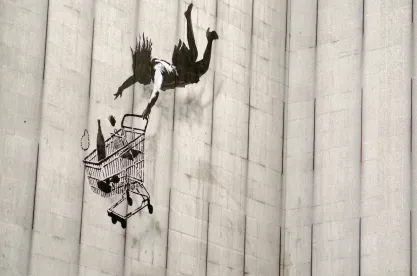The Second Circuit recently affirmed that a developer’s whitewashing of street art painted at the “5Pointz” warehouse complex in Long Island City was a violation of the Visual Artists Rights Act (“VARA,” codified at 17 U.S.C. § 106A). In its ruling, the Second Circuit held that (1) the potentially temporary nature of street art does not preclude its protection under VARA as a work of “recognized stature” and (2) the determination of the “recognized stature” of a work under VARA is most properly determined by the evaluation of a “relevant community”—typically the art community of art historians, art critics, museum curators, gallerists, prominent artists, and other experts.
Background of the 5Pointz Street Art Complex
In 2002, developer Jerry Wolkoff came to an oral agreement with artist Jerry Cohen under which Cohen would curate and regulate the “aerosol art” painted and displayed at Wolkoff’s warehouse complex. Under Cohen’s direction, the complex developed into a popular display area for many prominent and lesser known “street artists” and became a significant tourist attraction known as “5Pointz.” The spray paint murals of 5Pointz, however, were generally temporary. Many of the works displayed at 5Pointz were painted over by newer works—often under Cohen’s supervision—after various periods of display on the walls of the complex, with the murals’ tenure ranging from hours to years. See Cohen v. G&M Realty LP, 988 F. Supp.2d. 212, 224 (E.D.N.Y. 2013).
In 2013, Wolkoff sought to tear down the complex to make way for new development, but was sued under VARA by various artists, including Cohen, who sought to prevent or limit the destruction of the works and/or to delay their demolition to allow the photographing or other such preservation of the works as was possible. After the District Court denied the plaintiffs’ application for a temporary restraining order in November of 2013, Wolkoff—in an act that the District Court characterized as one of “pure pique and revenge”—oversaw the whitewashing of the 5Pointz complex’s graffiti. 5Pointz artists then sued Wolkoff for violation of their VARA rights by dint of such whitewashing and were awarded statutory damages for willful violation of VARA to the tune of $6.75 million by the Eastern District of New York.
On appeal in Castillo v. G&M Realty (No. 18-498-cv) and Cohen v. G&M Realty (No. 18-538-cv), the Second Circuit considered the question of whether the transitory nature of the defaced art precluded protection under VARA, which inter alia affords artists the right to prevent damage to works of “recognized stature,” as well as other acts that may harm their reputations or prospects. See (17 U.S.C. §106(A)). The Second Circuit further addressed the related question of under what circumstances could art be considered to have attained “recognized stature,” as the term had been left undefined in statutory law.
The Second Circuit’s Holding
The Second Circuit held that there was no suggestion of a temporal restriction on “recognized stature” in VARA and that, to the contrary, an installation such as Christo’s “The Gates” in Central Park had lasted a mere two weeks but attained “significant critical claim and attention.” The transient nature of a work did not bear on its protectability under VARA, and as long as a work of visual art was fixed for more than “transitory duration” (which could be as little as several minutes) and thus subject to copyright protection, it could also attain recognized stature.
The Second Circuit next turned to the question of how courts should make the determination of whether a work had indeed attained “recognized stature” (temporary or not), thus entitling the author to prevent acts (including demolition) that would result in its distortion or mutilation (17 U.S.C. §§ 106A(a)(3), 113(d)(1)), or, at a minimum, entitle an artist to a 90-day notice period in those instances in which a work could be safely removed from a building without damage to the work (17 U.S.C. § 113(d)(2)).
The Second Circuit held that a work is of recognized stature “when it is one of high quality, status, or caliber that has been acknowledged as such by a relevant community.” The court further held that the most important component would generally be “artistic quality” and that the relevant community would typically be “the artistic community, comprising art historians, art critics, museum curators, gallerists, prominent artists, and other experts.” Expert testimony would often thus be of tremendous import to the “recognized stature” determination.
The Second Circuit additionally held that the prominence of an artist was relevant to the stature of works created by that artist, and approvingly cited district court holdings that the prominence of an artist alone could render the artist’s works of recognized stature essentially per se. (Slip op. at 23 n.7) (citing Scott v. Dixon, 309 F. Supp. 2d 395, 400 (E.D.N.Y. 2004) (“[T]he court can imagine a set of circumstances where an artist’s work is of such recognized stature that any work by that artist would be subject to VARA’s protection . . . .”)). The Second Circuit particularly praised Banksy as an influential street artist and producer of work of “significant artistic merit and cultural importance” despite acknowledging that his work was “often painted on building walls where it may be subject to overpainting,” stating that “[a] Banksy painting at 5Pointz would have possessed recognized stature, even if it were temporary.” (slip op. at 18-19). As a corollary, the Second Circuit held that the curation of the 5Pointz works by a prominent artist such as Cohen—even where such curation took place in advance of the works’ actual creation (for example by approving artists’ sketches or plans) —was evidence that those works that were eventually created were more likely to be those of recognized stature. (slip op. at 23) (“An artist whose merit has been recognized by another prominent artist, museum curator, or art critic is more likely to create work of recognized stature than an artist who has not been screened. This inference is even stronger where, as here, Cohen reviewed a plan for the subject work before allowing it to be painted.”).
Possible Considerations for Property Owners:
One of the unanswered questions surrounding the 5Pointz case—particularly from the perspective of property owners—is the significance of ownership of the surface or building on which street art of “recognized stature” is painted. VARA, by design, does not impose a requirement that the title to the copy of the work in question be retained by the artist (that is, the artist’s “moral rights” are retained even after a copy of a work is sold). See 17 U.S.C. §106(e)(2) (reserving rights in the work under VARA to the artist notwithstanding transfer of title of a particular copy of that work). In the limit, then, even the author of a work recognized stature (perhaps, e.g., Banksy) that is forced on an unwilling owner (say, an owner who prefers clean, un-graffitied walls)”) could conceivably attempt to enjoin demolition of a building (or, at a minimum, force that owner to go through VARA procedures such as 90-day notice period if the wall containing such a work could be safely removed. See 17 U.S.C. §113(d)(2)(B))—even though the imposition of the street art on the building was itself an act of vandalism that did not create a title interest in the artist.
At the district court level, the Southern District of New York has held that “VARA does not apply to artwork that is illegally placed on the property of others, without their consent, when such artwork cannot be removed from the site in question.” English v. BFC&R E. 11th St. LLC, 97 Civ. 7446 (HB), 1997 U.S. Dist. LEXIS 19137, at *14 (S.D.N.Y. Dec. 2, 1997), but the issue has yet to be squarely addressed at the appellate level. See English v. BFC Partners, No. 98-7032(L), 98-7238, 1999 U.S. App. LEXIS 23697, at *2 (2d Cir. Sep. 27, 1999) (“Because we conclude that Farinacci’s appeal fails because it depends on a contention not presented to the district court, we need not decide whether his mural is entitled to protection under VARA[.]”). Conversely, the Northern District of New York has suggested that at least removable artwork is subject to VARA protection even if its placement is not made with the consent of the property owner, and further suggested that the statutory holding of English may be questionable. Pollara v. Seymour, 150 F. Supp. 2d 393, 396 n.4 (N.D.N.Y. 2001) (“English is limited to the situation where the artwork cannot be removed without destroying it. There is little, if any, dispute that it was possible to remove Pollara’s painting from its frame without damaging it. Moreover, there is no basis in the statute to find a general right to destroy works of art that are on property without the permission of the owner.”).
The direct conflict between property rights in real estate and street art protection under VARA was not at issue in the 5Pointz decision, as the Wolkoff/Cohen agreement had expressly permitted the use of the warehouse walls for street art displays. Nevertheless, at face value, the logic of the Second Circuit’s decision might suggest a novel approach to enjoining the demolition of a building whether or not you own it—entice Banksy to paint a building for you and then to bring suit to enjoin its destruction under VARA.
Fortunately for property owners, there is some suggestion in the Second Circuit’s opinion that such disputes would generally be resolved in favor of the property owner, notwithstanding that some works like those of Banksy might be accorded recognized stature essentially per se. See slip op. at 18 (“Though often painted on building walls where it may be subject to overpainting, Banksy’s work is nonetheless acknowledged, both by the art community and the general public, as of significant artistic merit and cultural importance.”). The Second Circuit’s caveat that even Banksy’s work of recognized stature would be “subject to overpainting” suggests the possibility that even Banksy would not have carte blanche to use his artistic output as a vehicle for appropriating property rights—but the ultimate resolution of this question may have to await subsequent cases.





 />i
/>i

